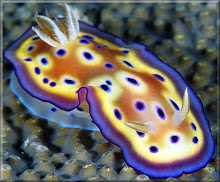
Sea anemones resemble flowers, but they are actually cnidarians, related to coral and jellyfish. They spend their lives rooted to surfaces using a big sticky foot. Their tentacles wave in the currents and catch any pieces of food or animals that pass by.

Sea anemones spend their larval stage as zooplankton floating in the currents. When they reach maturity, they settle on the sea bottom and anchor themselves.

The tentacles of a sea anemone are lined with tiny cells called nematocysts. These cells contain a microscopic spring loaded harpoon. When an unfortunate animal brushes by, the harpoon fires, ensnaring the victim and delivering deadly poison. Once the hapless victim is entangled, the anemone pulls it into its mouth. It digests the food in its stomach and excretes the waste back out through its mouth.

Sea anemones are often sought out as partners for other organisms which use their powerful poison as defense. Hermit crabs will often uproot small sea anemones and stick them on their backs. This serves the anemone well because it is now mobile and can more easily catch bits of food. It also gets to snack on any of the crab's leftovers. The crab benefits by having added protection from predators. Anything trying to eat the crab gets a powerful sting.

Another animal that uses the sea anemone as protection is the clown fish. These fish are adapted to keep the sea anemone from stinging them, and spend their entire lives nestled safely in their deadly tentacles.

Sea anemones come in many shapes, sizes, and colors, and can be found throughout the world, from the cold oceans of North America to tropical Australian coral reefs.

 Sea anemones resemble flowers, but they are actually cnidarians, related to coral and jellyfish. They spend their lives rooted to surfaces using a big sticky foot. Their tentacles wave in the currents and catch any pieces of food or animals that pass by.
Sea anemones resemble flowers, but they are actually cnidarians, related to coral and jellyfish. They spend their lives rooted to surfaces using a big sticky foot. Their tentacles wave in the currents and catch any pieces of food or animals that pass by. Sea anemones spend their larval stage as zooplankton floating in the currents. When they reach maturity, they settle on the sea bottom and anchor themselves.
Sea anemones spend their larval stage as zooplankton floating in the currents. When they reach maturity, they settle on the sea bottom and anchor themselves. The tentacles of a sea anemone are lined with tiny cells called nematocysts. These cells contain a microscopic spring loaded harpoon. When an unfortunate animal brushes by, the harpoon fires, ensnaring the victim and delivering deadly poison. Once the hapless victim is entangled, the anemone pulls it into its mouth. It digests the food in its stomach and excretes the waste back out through its mouth.
The tentacles of a sea anemone are lined with tiny cells called nematocysts. These cells contain a microscopic spring loaded harpoon. When an unfortunate animal brushes by, the harpoon fires, ensnaring the victim and delivering deadly poison. Once the hapless victim is entangled, the anemone pulls it into its mouth. It digests the food in its stomach and excretes the waste back out through its mouth. Sea anemones are often sought out as partners for other organisms which use their powerful poison as defense. Hermit crabs will often uproot small sea anemones and stick them on their backs. This serves the anemone well because it is now mobile and can more easily catch bits of food. It also gets to snack on any of the crab's leftovers. The crab benefits by having added protection from predators. Anything trying to eat the crab gets a powerful sting.
Sea anemones are often sought out as partners for other organisms which use their powerful poison as defense. Hermit crabs will often uproot small sea anemones and stick them on their backs. This serves the anemone well because it is now mobile and can more easily catch bits of food. It also gets to snack on any of the crab's leftovers. The crab benefits by having added protection from predators. Anything trying to eat the crab gets a powerful sting. Sea anemones come in many shapes, sizes, and colors, and can be found throughout the world, from the cold oceans of North America to tropical Australian coral reefs.
Sea anemones come in many shapes, sizes, and colors, and can be found throughout the world, from the cold oceans of North America to tropical Australian coral reefs.


No comments:
Post a Comment